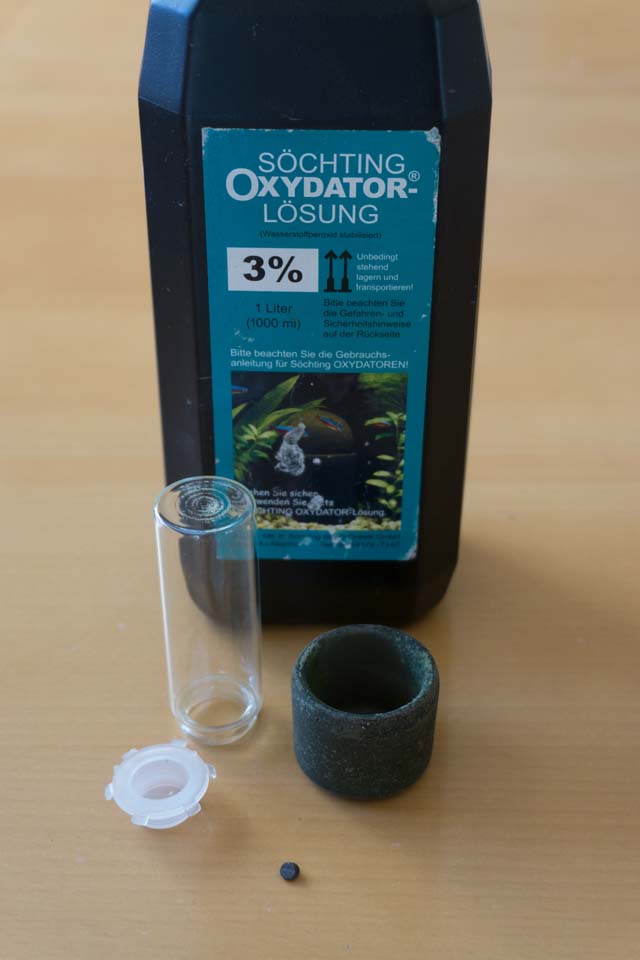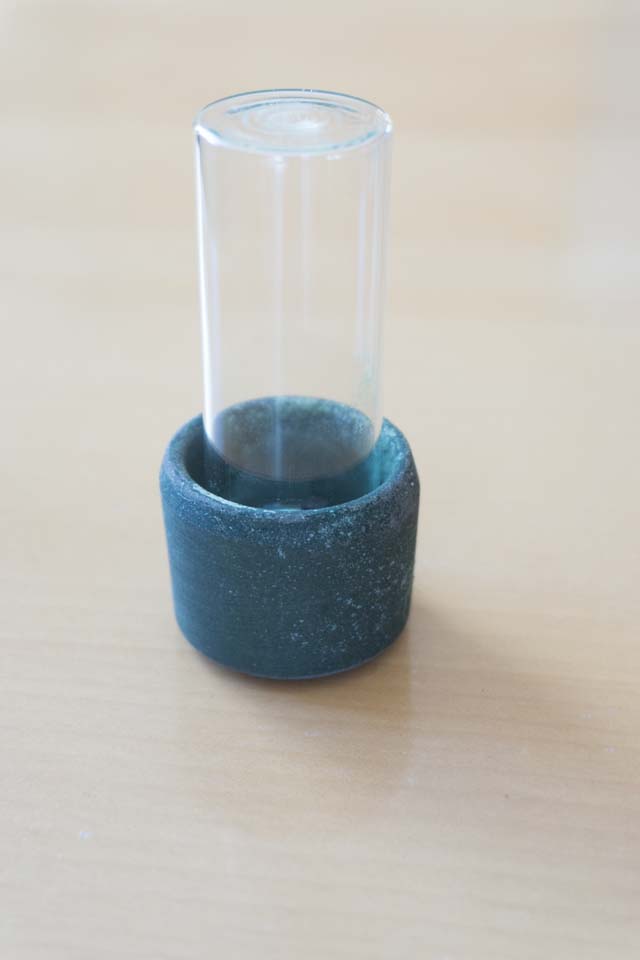Söchting Oxydator in the aquarium insert: What is an oxidizer anyway? What is one for? oxidizer needed? Require fish or shrimp an oxidizer? We want to examine these questions in more detail in the following article. You can read about the use of an oxidizer in the aquarium again and again, but many, especially beginners, do not know exactly what this device is actually for. Unfortunately, you have to dive into chemistry and water physics for this.

What is an oxidizer?
Especially under the name Söchting oxidizers you know the small devices or facilities. Basically, there are no devices, because it will be no electricity or connection required.
Oxydators are there for the water with more hydrogen peroxide to enrich The manufacturer himself even speaks of it hydrogen peroxide. Hydrogen peroxide 2H2O2 is used with a Special ceramics of the manufacturer is immediately broken down and becomes 2 H2O and O2, i.e. water and oxygen. This primarily increases the oxygen content in the water. The manufacturer speaks here of the transformation of hydrogen peroxide into molecular oxygen and water through a special patent.
To put it simply, it's about enriching the water with more oxygen. And this with a process that differs significantly from, for example, a diffuser with a membrane pump or an air stone. No electricity is required here and there are no bubbling bubbles either. In addition, there are no noises. However, an oxidizer solution is required for this. This is a special hydrogen peroxide solution that is available in different concentrations.
The amount of released Oxygen depends strongly on the temperature of the water. In the hot summer months, one finds again and again that bodies of water and ponds in particular have major problems with oxygen. Fish kills can be the result. Oxygen deficiency can also occur in our aquariums. Oxidizers prevent this.
How does an oxidizer work?
Of course, one wonders how such a device can work without electricity. Here the basis is the aqueous solution, which is hydrogen peroxide or hydrogen peroxide. This forms the basis. Large amounts of oxygen are stored in this liquid ready for use. The chemical notation here is H2O2, as already written above. H stands for hydrogen and the O is known for oxygen. Water consists of two Hydrogen atoms and a oxygen atom. This is also the difference to hydrogen peroxide, because the ratio between water and oxygen is the same here and there are 2 atoms of both. So here we have one another oxygen atom is available for storage, management and analysis.

But how do we get this solved now and can we release it to the environment and thus to the aquarium water? Ultimately, that is the exciting question. A so-called catalyst is used for this purpose. This catalyst is a small flake or a kind of stone which lies in a glass flask where the hydrogen peroxide is also filled. This is how the extra oxygen atom O2 is finally released.
Now it's just a matter of dosing it accordingly and creating a long-term effect. There is a special worldwide patent for this. The catalyst stone releases oxygen, as we have already described above. This creates an overpressure in the gas flask, which in turn releases oxygen and releases it through a small hole in the lid of the glass flask. The amount of liquid expelled depends on the activity of the catalyst and not on the size of this hole. This is why this little stone must be precisely matched to the respective aquarium and oxidizer size.
If you take a closer look at the pictures and the design, you will see that the container with the hydrogen peroxide solution is in a ceramic base. The leaked liquid has to get past this ceramic and this is where the actual reaction occurs. This is where the splitting into pure oxygen and water takes place. Now you can also see the very small bubbles, which are not yet visible when they emerge from the hole.
The reaction and dissolving of the oxygen with water takes place in the base through the special ceramic.
What are the advantages of such an oxidizer?
Now, of course, you have to ask yourself what I actually need the additional oxygen for in the aquarium and which ones Benefits arise from it. Once this has been understood, it is up to everyone to decide for themselves whether they want to use this technique or not. It can even become a must if you're really dealing with oxygen starvation.
Oxygen is essential for fish and without it they would suffocate. Only a few species of ornamental fish can use the oxygen in the atmosphere. Therefore, enough oxygen must be dissolved in the water. So one reason for using an oxidizer can be that you want to dissolve more oxygen in the water. This is reflected in the well-being of the aquarium inhabitants such as shrimp or ornamental fish.
Another advantage of using an oxidizer is that there is no Co2 and thus no nutrient for the plants expelled becomes. This is the case with a bubbler. If, for example, you rely on more surface movement of the water, then you always have to do with driving out the CO2 and thus reducing the amount of fertilizer for the plants. Most of the time this is not wanted. Especially not if additional Co2 is used as fertilizer.
If you have problems with the formation of rot and the cloudy water that is usually associated with it, you should also rely on the use of an oxidizer. Very quickly you will be able to look at a clear and clean water. It is also very useful in breeding because it prevents spawn fungus.
As you can see, there are a few reasons why it might be worth using an oxidizer.
The following reasons/advantages speak in favor of using the oxidizer:
- No more lack of oxygen for fish and shrimp
- No expulsion of CO2 like with a bubbler
- No rot formation
- reducing water turbidity
- Against spawn fungus
- Does not affect the pH value
Which Söchting oxidators are there?
Of course you have to pay attention to the size when choosing the oxidizers, because it depends on how much capacity the aquarium has. Oxydators are already available for nano aquaristics and for tanks up to 60 liters. This is called a mini. Size D can be used for up to 100 liters of aquarium water. There is also a size A which has a capacity of up to 400 liters. A combination of the different sizes is of course also possible.
If you want to equip your garden pond with it, you can buy size W Maxi, which has a capacity of up to 25.000 liters and size W has a capacity of 4.000 liters.
Which Oxydator solution do I actually need? (Hydrogen Peroxide 3% 6% or 12%)
Of course, you should also inquire in advance which solution you need if the original set does not have it. A solution is usually already included in the sets. As we have already noticed, this is given with a content of 4,9% and when it comes to buying the refill, many do not know which solution is the right one.
One thing right away. There used to be 19,9% and 30% Oxydator solutions. These are currently no longer available. Due to the change in the Chemicals Prohibition Ordinance, all hydrogen peroxide solutions over 12 percent were banned. Previously you could also buy solution over 12%.
If you have an aquarium and want to use the Oxydator there, you should buy either the 3% or the 6% solution. The 12% stabilized hydrogen peroxide solution is intended for the pond or garden pond.
But you should make sure that you only use and buy the original solution from Söchting. There is also a reason for this, because it was coordinated accordingly. Again and again you can read that aquarists get a solution from the pharmacy. Söchting's solution should also contain stabilizers. This is mainly to ensure a long-lasting effect. You should pay attention to that.
Where can I buy a Söchting Oxydator?
Of course, we have linked the most important solutions and devices for you accordingly. The prices don't give much away, although it is usually more expensive in specialist shops.
- aquariumplants.net
- Söchting Oxydator Mini for aquariums up to 60 liters
- AQUARIUM POND WATER TREATMENT
- Oxygen supply without electricity and hoses
- Oxygen even in winter under closed ice cover
- The oxygen also reaches deep, oxygen-poor areas.
- for aquaria up to 100 liters
- Oxygen supply without electricity and hoses
- Oxygen even in winter under closed ice cover
- The oxygen also reaches deep, oxygen-poor areas.
- for aquaria up to 400 liters
No products found.





